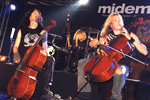
News Roundup
Cybersquatting Increases in 2005
WIPO’s Arbitration and Mediation Center saw a 20 percent increase in the number of cybersquatting cases (abusive registration of trademarks as domain names) filed in 2005 as compared to 2004. The 1,456 cases filed represent the highest number of cybersquatting cases handled in a single year by the Center since 2001.
"Notwithstanding the unique effectiveness of the UDRP as a global remedy against cybersquatting, the fact that WIPO’s caseload in 2005 was the highest in four years – and that many of these cases concern recently registered domain names – underlines the need for continued vigilance by intellectual property owners," said WIPO Deputy Director General Francis Gurry. He also noted that, while UDRP disputes have been heavily concentrated in the .com domain, attention must be paid to the establishment of effective preventive mechanisms against abusive registration in new generic Top Level Domains (gTLDs).
Since the inception of the Uniform Domain Name Dispute Resolution Policy (UDRP) in December 1999, WIPO’s Arbitration and Mediation Center has handled more than 8,350 disputes, involving parties from 127 countries and covering some 16,000 domain names. The UDRP’s popularity stems from its cost-effectiveness, the predictability of the process and swift enforcement of the results. Frequent users of the UDRP include the entertainment industry, pharmaceutical companies, IT firms, and a significant number of small-to-medium-sized businesses who favor the UDRP over traditional litigation as a quicker and cheaper way of protecting their trademark rights against cybersquatting.
All domain name decisions handled by the Center are indexed and published on the Center’s website (http://arbiter.wipo.int/domains/search/). The new WIPO Overview of WIPO Panel Views on Selected UDRP Questions, created to offer parties and panelists an overview of broad decision trends, is available at http://arbiter.wipo.int/domains/search/overview.
MIDEM – Music Industry Cheered by Digital Sales
 The Finnish rock band Apocalyptica performing at the MIDEM opening night party. (Credit: © CATARINA / CA / MIDEM /)
The Finnish rock band Apocalyptica performing at the MIDEM opening night party. (Credit: © CATARINA / CA / MIDEM /)
MIDEM, the international music industry event held each year in Cannes, France, celebrated its 40 th anniversary with a splash from January 21 to 26 with concerts and fireworks every night. Sir Bob Geldof, music producer Harvey Goldsmith and International Federation of the Phonographic Industry (IFPI) Chairman John Kennedy, organizers of last summer’s Live 8 ("make poverty history") concerts, jointly received the MIDEM 2006 Personality of the Year Award.
Despite a reported 1.9 percent fall in revenue in the global music market in 2005, the mood at MIDEM was generally upbeat on the news that booming demand for music on the Internet and mobile phones is offsetting the decline in demand for physical formats. The IFPI reported that digital sales had tripled to 6 percent of industry retail revenues, totaling US$ 440 million in the first half of 2005. The higher rates charged for mobile phone downloads also allows an increased return on investment for producers, distributors and artists.
Close to 10,000 music professionals from 92 countries spent the week discovering new sounds, negotiating deals, discussing tomorrow’s issues, and hearing from expert analysts. WIPO, sharing a booth with the Swiss Society for Authors' Rights in Musical Works, was used the opportunity to meet with collective management societies from around the world to discuss of the work done by the Organization in support of artists’ rights.
Innovation will Save the World, Teenagers Believe
American teenagers believe that new inventions will provide the answers to the world’s greatest problems, according to a survey carried out in the U.S. for the Lemelson-MIT * 2006 Invention Index, which gauges attitudes towards innovation. The vast majority of teenagers questioned were optimistic that science and technology will solve the problems of clean water (91 percent), world hunger (89 percent), disease eradication (88 percent) and pollution (84 percent). The teenagers also predicted that much current, every-day technology would become obsolete within the next ten years, citing gasoline-powered cars (33 percent), compact discs (26 percent) and desktop computers (22 percent) as destined for the scrap heap.
The teenagers’ faith in science and technology did not, however, appear to be reflected in their own career aspirations, with only nine percent of those questioned putting science as their top career choice.
____________________
* The Lemelson-MIT Program aims to make invention more accessible to young people.
Brussels Eureka – Innovation from Start to Finish
The 54 th edition of the Brussels Eureka innovation fair in November 2005 took a new approach to assist inventors looking to bring their products to market. The inventors were brought together with "business angels" offering advice on start-up financing, with organizations which facilitate administrative formalities in Belgium, and with university-business liaison groups; while Energex provided experts from across the field of conventional and renewable energies.
The combination worked well. Individual inventors set out their stalls alongside big businesses; raw ideas alongside tried and tested commercial successes; simple new energy-saving systems alongside displays of large scale energy production.
WIPO invention awards went to Fatemeh Omidi Beirgani of Iran for her device to measure the stability of tooth implants using sound; and to Ku Hamid Ku Halim, Alwi Habsah and Ibrahim Norliza of Malaysia, who invented a treatment for spent coolant using banana stem extract.
The WIPO Magazine is intended to help broaden public understanding of intellectual property and of WIPO’s work, and is not an official document of WIPO. The designations employed and the presentation of material throughout this publication do not imply the expression of any opinion whatsoever on the part of WIPO concerning the legal status of any country, territory or area or of its authorities, or concerning the delimitation of its frontiers or boundaries. This publication is not intended to reflect the views of the Member States or the WIPO Secretariat. The mention of specific companies or products of manufacturers does not imply that they are endorsed or recommended by WIPO in preference to others of a similar nature that are not mentioned.